|
|
| BriCal for Compound Addition - Money Calculating Machine 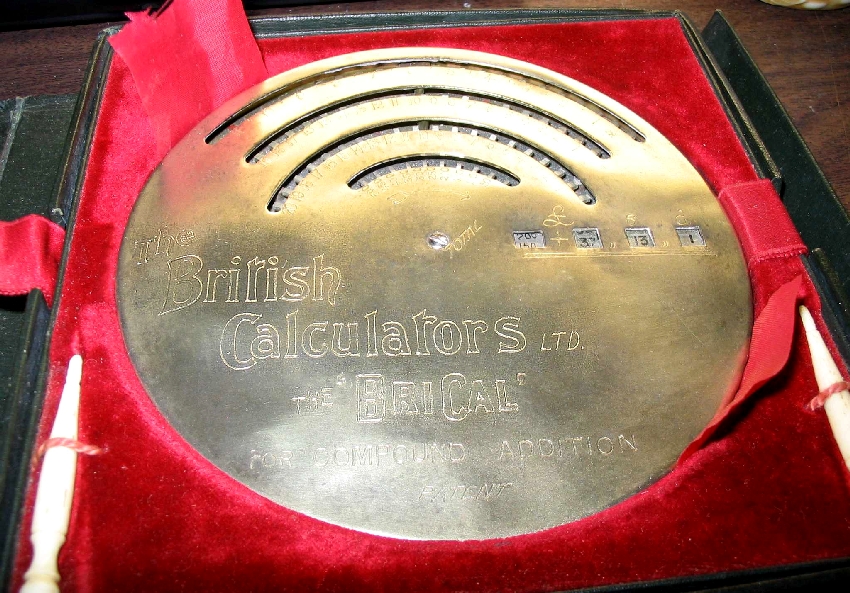
Bri-Cal - The British Calculators Ltd. BriCal for Compound Addition
Money Calculating Machine (for pounds, shilling, pence) circa 1910
Belfast Road, Stoke Newington, London
The BriCal is a beautifully crafted early calculator for summing in pre-decimal British currency, which had twelve pence in a shilling and twenty shillings to the pound. (Quick: what would be the total cost of three items priced at 1£-13s-11d? Try it on your favorite calculator - if you still can't figure it, maybe you need a BriCal! Answer is here at bottom) 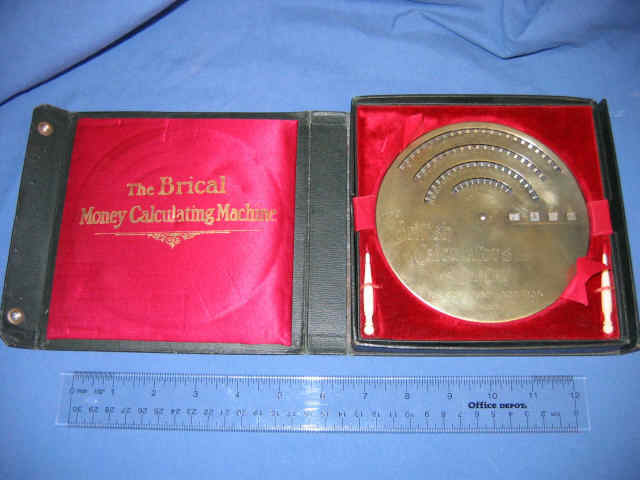
The BriCal is a brass disk about 13cm (5 inches) in diameter (though some models are larger). A pair of ivory styluses inhabits a leatherbound case lined with luxuriant red or blue velvet and satin, and bearing fancy silver or gold lettering. The BriCal shown has a serial number of 26031 and accommodates units as small as a half-pence. It has a maximum setting of two thousand pounds (less a half-pence); in the four windows this would show as '1950' + '49' pounds '19' shillings '11-1/2' pence.
To add cash amounts together, the stylus is inserted at the number desired and then moved clockwise (as indicated by the stamped arrow) to the end of the slot. This movement of the toothed ring advances the total as seen in the four result windows, and the carry operation between all rings is automatic. Subtraction is not supported. Clearing the calculator is done manually for each toothed ring. Each ring has a red tooth as a visual indicator of the zero position. Beginning with the outer ring, the operator slides the red tooth fully clockwise and repeats for each ring working inward. 10.JPG)
The above drawing is taken from the BriCal Instruction Booklet, which is available here, and shows the calculator with its components labeled. 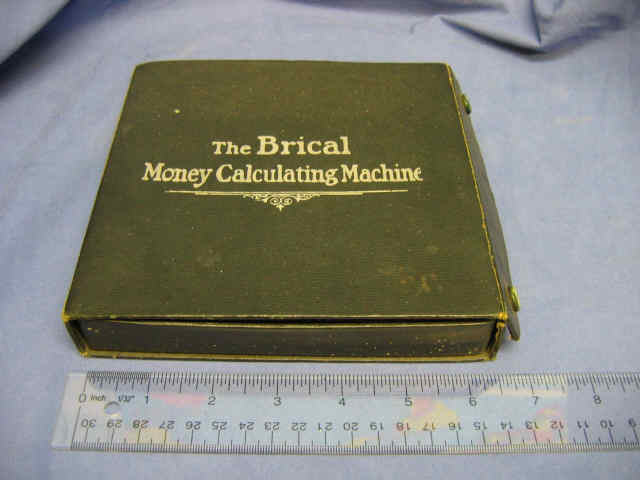
The Case is marked "The Brical Money Calculating Machine" Model B The most commonly encountered BriCal is the Model B shown below.
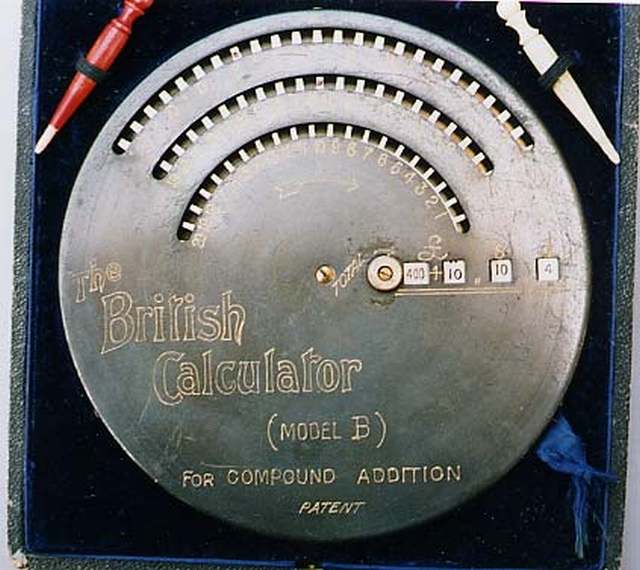
British Calculators BriCal for Compound Addition Model B In this most-typical configuration, we see three cogged rings exposed in symmetrically centered slots at the top of the disk, and four windows for the result, which can display a maximum value of 499£ 19s 11-1/2d. The inner result window is cleared by turning the adjacent brass dial called a 'finger set.'
.JPG) British Calculators BriCal Model B with Finger Ring
British Calculators BriCal Model B with Finger Ring
Source: V. Geppert
Not all BriCals with this configuration bear the Model B stamp, and it is not clear whether the Model B designation applies only to this particular configuration and series of manufacture, or whether it encompasses all the disk-shaped (i.e. concentrically ringed) calculators (as opposed to the non-concentric Model C). Other Configurations The BriCal was produced in a startling variety of configurations in order to accommodate different currency types and amounts, and even other units of measure such as weight. Note that the BriCal pictured at top (SN 26031) is similar to the Model B shown above but with a fourth slot (and no brass dial for zeroing) and a max. result of 2000£. This configuration is relatively uncommon. In fact, all configurations different than the Model B shown above may be considered rare. Many early BriCals have longer asymmetric slots that extend leftward into the lower half of the disc as shown below:
.JPG)
British Calculators BriCal Early Models The Brical on the left is divided into farthings and measures 15cm across with space for a 5th slot. The model on the right is 13cm with 4 slots, and has SN B46, which is among the earliest known. Above left you can see that the outer ring has narrow teeth for the counting of farthings, or quarter pence -- the scale is stamped with "1/4 1/2 3/4 1". Above right is a similar layout, but the outer ring has wide teeth for half pence -- the scale is stamped "1/2 1 ' 2". It seems that farthings became unworthy of accounting in the early 20th century (though the coin was minted until 1956), and so these longer slots gave way to the symmetrical arrangement seen further above.
.JPG) BriCal Early Model - 19cm Diameter in Wood Plate
BriCal Early Model - 19cm Diameter in Wood Plate
Source: V. Geppert
The BriCal pictured above measures 19cm (7.5in.) in diameter and has six concentric cogged rings corresponding to six result windows. (Note that the more common 13cm BriCal models can have a max. of 4 slots). Early BriCal SN A165 similar to the Model B layout but with long asymmetric slots
(courtesy of J. Lawrie)
Decimal BriCal SN D115 - Measures 18.5cm diameter Note the unusual coloring of the teeth: Red teeth (black tooth for zero) on the outer rings, Blue teeth (red tooth for zero) on the next, and white teeth (red tooth for zero) on the inner. (courtesy of V. Geppert)
.jpg)
BriCal SN E850 - Dollars and Cents Decimal Model with 6 slots
Source:
John Wolff
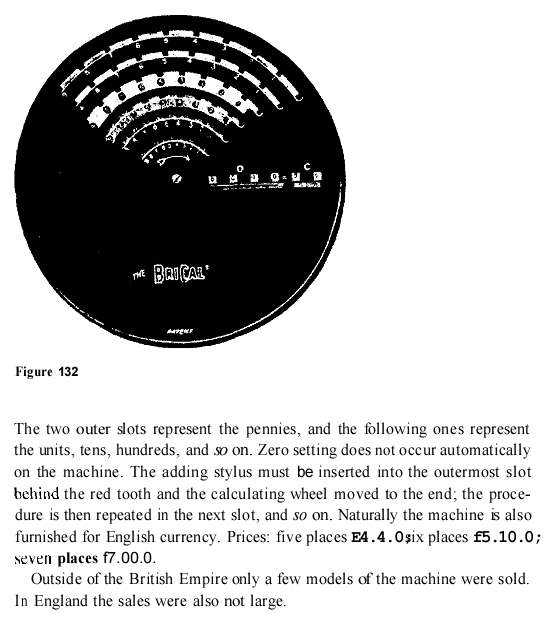
Decimal "D and C" BriCal for Dollars and Cents, Drawing and Excerpt from Martin text (US p 165)
Above is an excerpt from the US translation of the Martin text showing a six digit decimal BriCal for dollars and cents. I believe the prices shown are in pounds (the OCR software likely misread the '£' as an 'E' or 'f'). The text states that "In England the sales were also not large." Based on the serial numbers I have seen, I'd guess total units produced was on the order of twelve thousand.
.JPG) A pair of BriCals with a subsidiary vertical slide spanning 2,000£ to 20,000£ (see inset)
A pair of BriCals with a subsidiary vertical slide spanning 2,000£ to 20,000£ (see inset)
Source: Brekker and rechenwerkzeug.de.
British Calculators BriCal Weight Adding Machine (13cm diameter)
Paint and Finish
Note that the Brical pictured above, which is for adding weight measured in decimal pounds, has a black enamel (flat) finish with white painted numerals and lettering. This finish gave the numbers greater contrast for visibility, which you can also see below.
.JPG) BriCal SN 26033 - painted white enamel lettering on flat black (Source: RetroCalculators.com)
BriCal SN 26033 - painted white enamel lettering on flat black (Source: RetroCalculators.com)
Other BriCals are often seen with a thin lacquer-like (glossy) black finish, with the stamped numerals and lettering showing the brass beneath.
.JPG) BriCal SN U141 - 19cm in diameter with 6 slots
BriCal SN U141 - 19cm in diameter with 6 slots
Black lacquer finish with lettering stamped into the brass disk
Note that some of the stamped numbers are painted red
Finally, many BriCals (especially those with higher serial numbers) have the bare brass finish seen in the topmost photo. On early models, the serial number is stamped onto a small brass or copper disk on the back, while later models typically have the SN stamped on the side, as shown below.
The mark "T.J. Marshall & Co Mnfrs" is sometimes stamped on the side of a BriCal, alongside the serial number. I have encountered serial numbers as low as A26 and as high as 30949 (though none so far appear in the range from 2100 to 22000). I am hoping to discover a pattern among the serial numbers relating to year of production, layout and markings. If you have or know of a BriCal and can let me know the serial number, or have other helpful information, please send me a note ). In the examples I have seen so far, it appears that BriCals with symmetrical slots that are for British currency (such as those stamped on the front with 'Model B', or as seen in the topmost photo) will have a 'plain' serial number, while others will include a single letter prefix, such as 'A', 'B', 'D', 'E', 'G', or 'U'. The letter apparently corresponds to the configuration, e.g. 'D' may be for a decimal configuration, 'B' is often used for British currency with non-symmetrical slots, while 'G' may be for imperial weight measure (lbs,qtrs,cwt,tons), as shown below.
.jpg) Brical for imperial weight measure (lbs,qtrs,cwt,tons) with 6 slots
Brical for imperial weight measure (lbs,qtrs,cwt,tons) with 6 slots
CWTS is hundredweight (112 lb) and QRS is quarter (28 lb) while a long ton is 2240 lb
Leather pouch has ivory stylus and silk label with oval trademark. SN is G842 as shown
This was used by a cargo inspector at the Port Adelaide docks in South Australia
source ebay.au (courtesy of
John Wolff
)
Relating SN to date of production is difficult. I suspect that the date range for the BriCal is between 1904 and roughly 1915. Ernst Martin, author of The Bible of mechanical calculating machines, wrote in 1925 that the firm 'apparently no longer exists.' Trademarks and Lettering BriCals exhibit a wonderful variety of extravagant and fanciful marks and lettering. The 'BriCal' nickname appears on many but not all models. For example, BriCals of intermediate age often bear an oval logo with the Bri-Cal moniker and the words 'Adding Machines' across a central sash, as seen below.
.JPG) BriCal oval logo - stamped or engraved into brass disk
BriCal oval logo - stamped or engraved into brass disk
Source: V. Geppert
.JPG) BriCal oval logo - painted in white enamel (source: ebay)
BriCal oval logo - painted in white enamel (source: ebay)
.jpg)
British Calculators BriCal Embroidered Oval Logo From Case Lining
Source:
John Wolff
The case sometimes included an embroidered oval logo as seen above. The lining of the case was typically of luxuriant satin or velvet with stylized lettering in silver or gold.
.JPG)
Red or blue satin was used with gold or silver fancy lettering for the case lining.
These two shown are from different BriCal pieces of similar age.
The outer case and lining are often marked with "The Brical Money Calculating Machine"
Purple and blue lining from a pair of Model C cases, Note the font differs slightly. The 's' at the end of 'Calculator' appears in later models. This BriCal box lid bears the mark of the well-known Ross Opticians New Bond St. London
The lower right inset shows the serial number A165 stamped upon the back of the calculator (courtesy of J. Lawrie)
Internal Mechanism and Patent Info
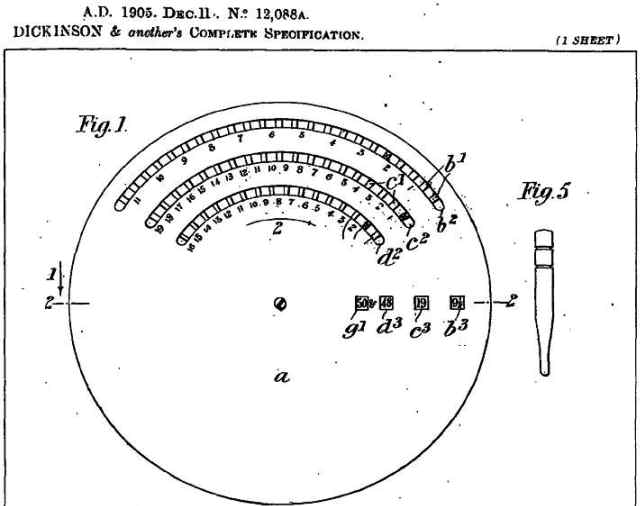
British Patent 12088A Figure 1 - 7 H & M Dickinson 1905
(courtesy V. Geppert) The BriCal was patented by Herbert Dickinson ('Engineer') and Mabel Dickinson ('Married Woman') in 1905 with British patent number 12088 and with the title 'Improvements in Counting and Adding Machinery' (Thanks to Volker Geppert for the patent pdf).
.jpg)
British Calculators BriCal Internal Assembly Above is an example of the BriCal internal assembly. This comes from the rechenwerkzeug.de site, which has a good description (in German) of the mechanism -- please take a look (here is an English translation courtesy of Google)! Model C
The Model C is quite distinct and rare. It has three non-concentric cogged rings as shown below.
 The British Calculator Model C For Compound Addition circa 1908
The British Calculator Model C For Compound Addition circa 1908
I know of only three serial numbers for the Model C, C79 and C377 (thanks to Ian Ritchie) and C430 (thanks to James Dolman). If you have some helpful knowledge about the Model C, please send a note, thank you! Kosmos The same firm apparently also manufactured the Kosmos mechanical calculator, which was also for British Currency. It included three keys (shown on the right) for farthings (quarter pennies).
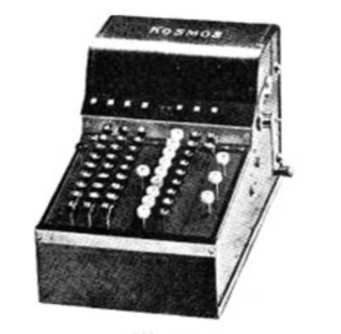
The British Calculators Ltd. Kosmos Mechanical Calculator Links: The BriCal Instruction Booklet is available here. Here's a museum reference site with some photos and dates: and another: (As mentioned above, I strongly suspect the 1950 date shown there is in error. Note that dates of 1914-1915 are also given, seemingly in conflict. I am looking for any reference that suggests these were manufactured later than the 1910s.)
| |
|
|